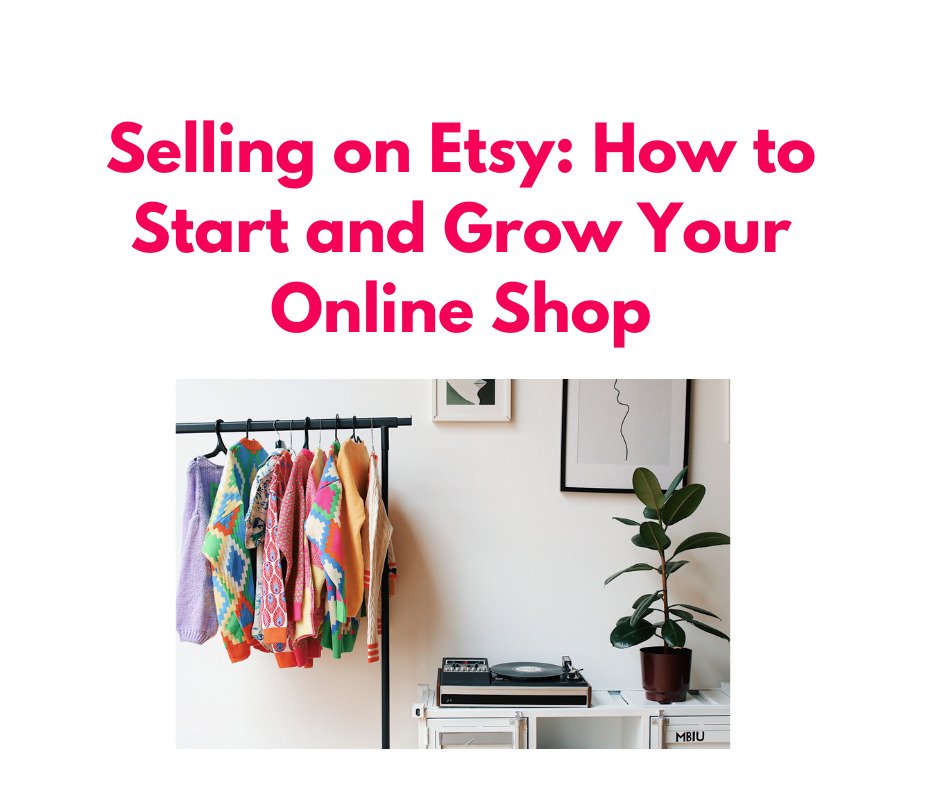
Ready to turn your passion for crafting into a profitable business? Our guide to selling on Etsy has got you covered! Learn how to set up and grow your online shop with our step-by-step instructions, from creating an account to attracting customers and optimizing your listings. Discover the insider tips and tricks to maximize your profit potential on this popular e-commerce platform and start earning money from home today!
Etsy is a popular e-commerce platform that provides a unique opportunity for stay-at-home moms to sell their handmade products and turn their creativity into profit. With millions of active buyers, setting up a shop on Etsy can be a lucrative way to earn money from home.
However, creating a successful Etsy shop takes more than just posting a few products and waiting for the sales to roll in. In this guide, we’ll walk you through the steps to start and grow your Etsy shop, from setting up your account to optimizing your listings and attracting customers.
Also Read –10 Easy Crafts for Stay-at-Home Moms to Sell and Make Money
Whether you’re a seasoned seller or just starting out, our tips and tricks will help you unlock the full profit potential of your Etsy shop.
Setting up Your Etsy Shop: Creating an Account, Profile, and Policies
Etsy is an online marketplace that allows individuals to sell handmade, vintage, and unique items. Setting up your Etsy shop is the first step to starting your online business. In this section, we will walk you through the process of creating an account, setting up your shop profile, and creating shop policies.
Creating an Etsy Account
The first step in setting up your Etsy shop is to create an account. To create an account, go to Etsy.com and click on the “Register” button. You can create an account using your email address, Facebook account, or Google account.
Setting up Your Shop Profile
Once you have created your account, it’s time to set up your shop profile. This is where you can showcase your brand and tell potential customers about your products. Your shop profile should include:
- A shop name and logo
- A shop description that tells your story and describes your products
- A banner image that represents your brand
- Contact information, such as your email address and social media accounts
Creating Shop Policies
Shop policies are the rules and guidelines that govern your Etsy shop. These policies help to establish trust with your customers and ensure a positive buying experience. Your shop policies should include:
- Shipping and handling policies, including processing times, shipping methods, and tracking information
- Payment policies, including accepted payment methods and refund policies
- Return and exchange policies, including how to initiate a return or exchange and any restocking fees
- Privacy policies, including how you handle customer data and information
By creating a clear and comprehensive set of shop policies, you can establish trust with your customers and set expectations for your shop. Make sure to regularly review and update your policies as your business grows and changes.
Also Read – 15 Low cost Profitable Business Ideas for Stay-at-Home Moms: Start Your Own Business from Home Today!
Creating High-Quality Listings: Product Photography, Descriptions, and Tags
Creating high-quality listings is key to attracting and retaining customers on Etsy. In this section, we will discuss three important elements of a successful listing: product photography, descriptions, and tags.
Product Photography
Your product photos are the first thing that customers see when browsing your Etsy shop. Therefore, it’s essential to invest time and effort in creating high-quality product images. Here are some tips to help you take great product photos:
- Use natural lighting: Photograph your products in natural light to ensure accurate colors and avoid harsh shadows.
- Use a clean background: Choose a simple, uncluttered background that doesn’t distract from your product.
- Show your product from multiple angles: Provide several photos that show your product from different angles so that customers can get a clear idea of what they are buying.
- Use a tripod: A tripod can help keep your photos steady and avoid blurry images.
Product Descriptions
Your product descriptions should provide detailed and accurate information about your products. A good product description should:
- Clearly describe what your product is and what it does
- Highlight any unique features or benefits of your product
- Provide sizing and measurement information
- Mention any care instructions or special handling requirements
Your product descriptions should also be well-written, engaging, and easy to read. Consider using bullet points to break up long paragraphs and make your descriptions more scannable.
Tags
Tags are keywords that help customers find your products when they search on Etsy. When creating tags, think about the words and phrases that customers might use to search for your products. Here are some tips for creating effective tags:
- Use specific keywords: Choose specific, relevant keywords that accurately describe your product.
- Use long-tail keywords: Long-tail keywords are longer phrases that are more specific and targeted. For example, “handmade ceramic coffee mug” is a more specific and targeted keyword than just “coffee mug.”
- Use all 13 tags: Etsy allows you to use up to 13 tags per listing, so make sure to use them all.
By following these tips, you can create high-quality listings that showcase your products and help you stand out on Etsy. Remember to regularly review and update your listings to ensure that they continue to reflect your brand and meet the needs of your customers.
Shipping and Handling: Setting Up Your Shipping Profiles and Calculating Shipping Costs
When you’re setting up your Etsy shop, it’s important to think carefully about shipping and handling. After all, you want your products to arrive safely and quickly, but you also need to keep your costs under control. Here are some tips for setting up your shipping profiles and calculating shipping costs.
- Choose Your Shipping Carrier: The first step is to decide which shipping carrier you want to use. The most popular options for Etsy sellers are the US Postal Service, FedEx, and UPS. Each carrier has its own strengths and weaknesses, so it’s important to do your research before making a decision.
- Set Up Your Shipping Profiles: Once you’ve chosen your shipping carrier, you’ll need to set up your shipping profiles on Etsy. This involves entering your shipping preferences, such as your shipping origin, shipping destinations, and shipping service levels.
- Calculate Your Shipping Costs: To calculate your shipping costs, you’ll need to take into account a variety of factors, including the weight and dimensions of your package, the shipping destination, and the shipping service level you’ve chosen. Most shipping carriers have online calculators that can help you determine the cost of shipping your package.
- Consider Free Shipping: Many Etsy sellers offer free shipping as a way to attract more customers. If you choose to offer free shipping, you’ll need to build the cost of shipping into your product prices. This can be a good option if you sell small, lightweight items that are easy to ship.
- Package Your Items Carefully: Finally, make sure you package your items carefully to ensure that they arrive at their destination in good condition. This may involve using bubble wrap, packing peanuts, or other protective materials to prevent damage during transit.
By taking the time to set up your shipping profiles and calculate your shipping costs carefully, you can ensure that your products arrive safely and quickly, while also keeping your costs under control.
Setting up shipping profiles and calculating shipping costs are crucial to ensure that your customers receive their orders on time and in good condition. To help you with this process, consider investing in the following products from Amazon.com:
- Shipping scales: Accurately weighing your packages is essential to determine the correct shipping costs. This Digital Postal Scale is a highly rated and affordable option.
- Shipping labels: Printing your own shipping labels can save you time and money compared to handwriting them. These Shipping Labels with TrueBlock Technology are easy to customize and compatible with most printers.
- Packing materials: To safely and securely package your items, you’ll need various packing materials such as boxes, bubble wrap, packing peanuts, or packing tape. This packaging tape and Bubble Cushioning Wrap are reliable options for securing and protecting your packages.
- Shipping software: If you have a high volume of orders, shipping software like ShipStation can automate and streamline your shipping process, saving you time and hassle.
Managing Your Inventory and Orders: Tips for Staying Organized
As an online seller, keeping track of your inventory and orders is crucial to the success of your business. In this article, we will provide some tips for managing your inventory and orders effectively.
- Keep a record of your inventory: Before you start selling on Etsy, it’s important to keep a record of your inventory. This will help you keep track of what products you have available, what needs to be restocked, and what items are selling the most.
- Set up your inventory management system: You can use a spreadsheet or inventory management software to keep track of your inventory. This will help you see what items are selling the most and what needs to be restocked.
- Keep your inventory up-to-date: Make sure you update your inventory regularly, so you always know what products are available and what needs to be restocked.
- Use SKU numbers: Assign SKU numbers to your products to make it easier to keep track of your inventory.
- Fulfill orders promptly: When an order comes in, make sure you fulfill it promptly. This will help you maintain a good reputation and keep your customers happy.
- Use a shipping and handling calculator: Etsy provides a shipping and handling calculator that you can use to calculate the cost of shipping your products. This will help you set the right shipping fees and avoid overcharging or undercharging your customers.
Marketing Your Etsy Shop: Social Media, SEO, and Paid Advertising
As an Etsy seller, marketing your shop is crucial to increase visibility and drive sales. With millions of active buyers on Etsy, it’s important to utilize various marketing techniques to reach your target audience. Here are some tips for marketing your Etsy shop:
- Utilize Social Media: Social media platforms like Instagram, Facebook, and Pinterest are great tools to promote your Etsy shop. Share high-quality images of your products, and engage with potential customers through comments and direct messages.
- Optimize Your Etsy Shop for SEO: Use relevant keywords in your shop title, product titles, and descriptions to improve your shop’s search ranking. Additionally, make sure to include accurate and detailed information about your products to help customers find what they’re looking for.
- Paid Advertising: Etsy offers a variety of paid advertising options, including Promoted Listings and Google Shopping ads. These tools can help increase your shop’s visibility and drive sales.
- Participate in Etsy Teams: Joining Etsy teams can help you connect with other sellers in your niche and promote each other’s products.
- Offer Sales and Discounts: Offering sales and discounts can incentivize customers to make a purchase and help you stand out from competitors.
By utilizing these marketing techniques, you can increase your Etsy shop’s visibility and ultimately drive more sales.
Providing Great Customer Service: How to Build and Maintain Positive Relationships with Your Customers
When it comes to running a successful Etsy shop, providing exceptional customer service is key. Your customers’ satisfaction can impact your shop’s reputation, reviews, and even future sales. In this article, we’ll dive into some practical tips for providing great customer service on Etsy.
- Communicate effectively: Be prompt and professional in all your communications with customers. Respond to messages and inquiries in a timely manner, and use a friendly and helpful tone.
- Handle customer complaints with care: If a customer has an issue with their order, take the time to listen and understand their concerns. Work with them to find a solution that meets their needs, whether that means offering a refund, replacement, or other resolution.
- Go above and beyond: Consider adding a personal touch to your customer interactions, such as including a handwritten thank-you note with their order or offering a small free gift. These small gestures can go a long way in building customer loyalty and satisfaction.
- Focus on quality: Deliver high-quality products that meet or exceed your customers’ expectations. Pay attention to details such as packaging and shipping, and strive to provide a positive overall experience.
- Utilize social media and SEO: Leverage social media platforms and optimize your Etsy shop for search engines to increase visibility and attract more customers.
By following these tips, you can build strong and positive relationships with your customers, which can lead to increased sales and a thriving Etsy shop.
Tracking Your Shop Performance: Using Etsy’s Analytics Tools to Monitor and Improve Your Sales
As an Etsy seller, it’s important to keep track of your shop’s performance and make data-driven decisions to improve your sales. Thankfully, Etsy provides a variety of analytics tools to help you do just that.
One of the most important tools is the Etsy Shop Dashboard, which provides a snapshot of your shop’s performance over time. This includes information on your views, favorites, and sales, as well as your conversion rate and revenue.
In addition to the Shop Dashboard, Etsy also offers the Shop Stats tool, which provides more detailed information on your shop’s performance. This includes data on your traffic sources, top-performing listings, and customer demographics.
To get the most out of these analytics tools, it’s important to regularly review your data and make changes based on your findings. For example, if you notice that a particular listing is getting a lot of views but few sales, you may want to adjust the price or improve the product photos to increase conversions.
By regularly tracking your shop’s performance and making data-driven decisions, you can improve your sales and build a successful Etsy business.
Expanding Your Shop: Diversifying Your Products and Offering Custom Orders
Expanding Your Shop: Diversifying Your Products and Offering Custom Orders
One of the keys to growing your Etsy shop is to continually diversify your product offerings. This not only gives your customers more options to choose from, but it also helps you stay competitive in the marketplace. Here are some tips for expanding your shop and offering custom orders:
- Research and test new product ideas: Look at what is trending on Etsy and in your niche, and come up with new ideas for products that would complement your existing offerings. Consider testing out new products in small batches to gauge customer interest and demand.
- Offer custom orders: Providing customers with the option to request custom orders can be a great way to increase sales and customer satisfaction. Make sure to communicate clearly with your customers about the process for requesting and fulfilling custom orders.
- Collaborate with other sellers: Partnering with other Etsy sellers can be a great way to expand your product line and reach new audiences. Look for sellers in complementary niches and consider creating co-branded products or bundles.
- Leverage Etsy’s promoted listings and advertising options: Etsy offers several advertising options to help you get your products in front of more potential customers. Consider experimenting with promoted listings, Etsy Ads, and social media advertising to see what works best for your shop.
- Stay organized: As your product line and customer base grow, it’s important to stay organized to ensure that you can fulfill orders efficiently and keep track of your inventory. Consider using inventory management tools and outsourcing tasks like shipping and fulfillment to third-party services if needed.
By continually expanding and diversifying your product offerings, offering custom orders, collaborating with other sellers, leveraging Etsy’s advertising options, and staying organized, you can grow your Etsy shop and increase your sales over time.
Understanding Fees and Taxes: How Etsy’s Fees and Taxes Work and How to Manage Them
If you’re planning to start an Etsy shop, it’s important to understand how the platform’s fees and taxes work. Here’s a breakdown of the most important things you need to know:
- Etsy Fees: Etsy charges a listing fee of $0.20 per item, and a transaction fee of 5% on each sale, which includes the cost of shipping. If you use Etsy Payments to accept payments, there is an additional payment processing fee of 3% + $0.25 per transaction.
- Sales Tax: Depending on your location and the location of your customers, you may be required to collect sales tax on your sales. Etsy has a built-in sales tax calculator that automatically calculates the correct sales tax rate for each transaction.
- Income Tax: As an Etsy seller, you are considered self-employed and responsible for reporting your income and paying income tax on your profits. It’s important to keep accurate records of all your income and expenses, and to consult with a tax professional to ensure you’re meeting all your tax obligations.
By understanding how fees and taxes work on Etsy, you can ensure you’re pricing your products correctly and accurately tracking your income and expenses.
Growing Your Etsy Business: Scaling Up and Taking Your Shop to the Next Level
As an Etsy seller, it’s natural to want to grow your business and take it to the next level. Whether you’re looking to increase your sales, expand your product line, or reach a wider audience, there are a number of strategies you can use to grow your Etsy business.
Here are some tips to help you scale up your Etsy shop and take it to new heights:
- Invest in marketing: As your shop grows, you’ll want to invest more in marketing to reach new customers. Consider running social media ads, optimizing your listings for search engines, and offering discounts and promotions to incentivize sales.
- Expand your product line: Diversifying your product line can help you appeal to a wider audience and increase your sales. Consider adding complementary products or creating a new line of items that builds on your existing brand.
- Improve your customer service: Providing great customer service is key to building a loyal customer base and growing your business through word-of-mouth referrals. Make sure you’re responding promptly to customer inquiries, offering easy returns, and going above and beyond to exceed customer expectations.
- Consider outsourcing: As your business grows, it may become necessary to outsource certain tasks, such as product manufacturing or shipping. This can help you free up time to focus on growing your business in other ways.
- Network with other Etsy sellers: Networking with other Etsy sellers can be a great way to learn from others and get new ideas for growing your business. Consider joining Etsy seller groups on social media or attending in-person events to connect with other sellers.
By implementing these strategies, you can take your Etsy business to new heights and achieve the success you’ve been dreaming of.
Also Read – Discover the top 15 online survey sites where you can earn money without any investment
In conclusion, starting and growing an Etsy business can be a challenging yet rewarding experience for stay-at-home moms looking for a way to earn income while pursuing their passions.
By following the tips and strategies outlined in this article, you can set up a successful online shop, attract customers, and provide exceptional service to build a loyal customer base.
With dedication and hard work, you can take your Etsy business to the next level and achieve your financial and personal goals. So why not take the first step today and start your own Etsy shop?







